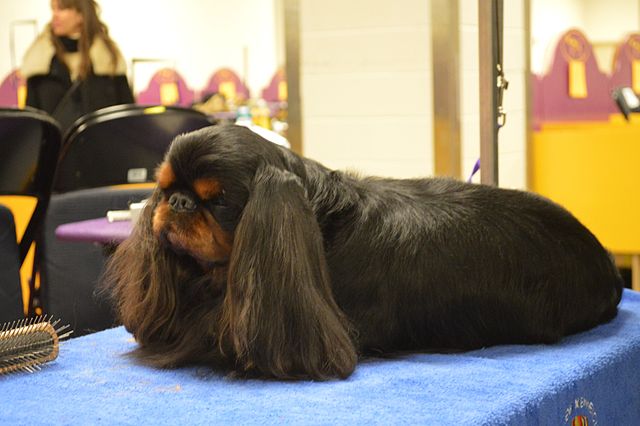


The English Toy Spaniel is a small, affectionate, and elegant companion dog known for its sweet nature and charming appearance. This breed is often recognized for its distinctive round face, large dark eyes, and long, silky coat. English Toy Spaniels are typically calm and friendly, making them excellent pets for families, seniors, and apartment dwellers. They enjoy being around people and are particularly fond of being cuddled and pampered. Despite their small size, they have a strong bond with their owners and thrive in a loving, gentle environment.
The English Toy Spaniel has a long history that dates back several centuries, with origins in England. The breed was originally developed as a companion dog for the British aristocracy, including royalty, where they were highly valued for their gentle demeanor and beauty. They were often kept in the laps of ladies and noble families and became popular during the Victorian era. The breed is believed to have descended from the King Charles Spaniel, which was brought to England from Spain in the 16th century. Over time, the English Toy Spaniel was refined to have the distinctive flat face and short muzzle that we recognize today. They were sometimes referred to as “Charlies” in reference to King Charles II, who was particularly fond of the breed. The English Toy Spaniel is distinct from the Cavalier King Charles Spaniel, which has a slightly different appearance and temperament. The breed was officially recognized by the American Kennel Club (AKC) in 1891.
The English Toy Spaniel is a small, compact dog, typically weighing between 8 to 14 pounds and standing about 9 to 11 inches tall at the shoulder. They have a distinctive, round head with a short, blunt muzzle, which contributes to their expressive, sweet face. Their large, dark eyes are one of their most defining features, often giving them an endearing, slightly "worried" expression. The breed’s coat is long, silky, and flowing, requiring regular grooming to maintain its elegance. Common colors for the English Toy Spaniel include black and tan, chestnut and white, and red. Their ears are long and feathered, and their tail is often carried slightly curved over their back. The breed’s overall appearance exudes refinement, and they are often described as having a regal, aristocratic look.
The English Toy Spaniel is known for its affectionate and calm temperament. They are gentle, friendly, and often form strong bonds with their families. These dogs are particularly well-suited to homes where they can receive plenty of attention and love, as they enjoy being close to their owners. While they can be reserved around strangers, they are typically not aggressive and tend to warm up to people over time. English Toy Spaniels are quiet dogs and are less likely to bark excessively, though they may alert their owners to unusual sounds. They have a playful side but are generally not overly energetic, making them great companions for those who enjoy a more relaxed lifestyle. They do best in homes where they are treated with kindness and patience, as they are sensitive to harsh treatment.
The English Toy Spaniel is a relatively low-energy breed, making them well-suited for apartment living and families who do not have large yards. While they enjoy daily walks and some indoor play, they do not require intense physical activity. A short walk and some playtime indoors are usually sufficient to keep them happy and healthy. However, they do enjoy mental stimulation and may benefit from interactive toys and activities that challenge their intelligence. Despite their calm nature, it is important to ensure they get enough exercise to maintain a healthy weight and prevent obesity, which they are prone to due to their small size. They should be kept on a leash during walks, as their small size makes them vulnerable to being startled or overwhelmed by larger dogs.
The English Toy Spaniel is an intelligent and eager-to-please breed, which makes them relatively easy to train. However, they can also be a bit independent at times, so consistent and gentle training methods work best. Positive reinforcement techniques, such as praise, treats, and play, are effective in encouraging good behavior. Early socialization is important for English Toy Spaniels to ensure they grow up to be well-adjusted dogs. Exposing them to a variety of people, environments, and other pets during puppyhood can help them develop confidence and reduce potential fearfulness. While they are generally friendly, their somewhat reserved nature may require extra effort in socializing them with strangers and other animals. Consistent, positive experiences during their formative months will help them grow into well-mannered companions.
The English Toy Spaniel is generally a healthy breed, but they can be prone to certain health issues, such as heart problems, eye conditions, and dental issues. Some common health concerns include mitral valve disease (a heart condition), cataracts, and retinal problems. Regular veterinary check-ups are essential for early detection and management of these conditions. They are also prone to obesity, so portion control and a balanced diet are important for maintaining their health. Grooming is an important part of their care routine, especially due to their long, silky coat. Regular brushing helps prevent tangles and mats, and their ears should be checked and cleaned regularly to prevent infections. Routine dental care, including brushing their teeth, is also important to prevent dental disease.
The English Toy Spaniel typically has a lifespan of 10 to 12 years. With proper care, including a nutritious diet, regular exercise, and routine veterinary visits, they can live a long, healthy, and happy life. While they are generally healthy, regular health screenings and preventive care are essential to managing any potential health issues. Keeping them at a healthy weight and providing regular dental and eye care will help extend their lifespan and improve their quality of life as they age.
© copyright Dog Compendium 2024 - 2025